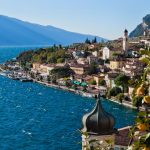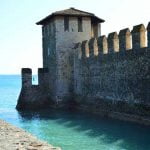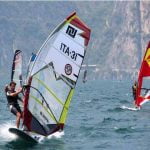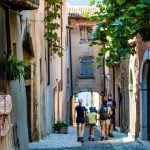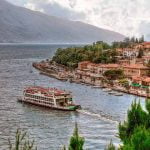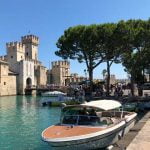Lake Garda, which is also known as Benaco, is located between three regions of Northern Italy: Lombardy, Veneto, and Trentino-Alto Adige. Formed as a result of glaciers, Lake Garda is the largest lake in Italy.
According to scholars, the ancient name Benacus is of Celtic origin and refers to the surrounding hills. Garda, on the other hand, appeared during a later period and refers to the locality of the same name on the eastern shore. Garda seems to be the evolution of the Germanic word warda, “guard” or “high place for military observations.”
Today, Lake Garda is characterized by picturesque towns that dot its shoreline surrounded by the impressive peaks of the Dolomites. The lake is an excellent destination for those who prefer a bit of relaxation in addition to sightseeing.
PREHISTORY OF LAKE GARDA
From a geological point of view, the rift valley that contains the lake basin and the surrounding mountains can be dated back to approximately 35 million years ago.
Between 5 and 2.5 million years ago, the Garda area, including the Po Valley, was covered by the sea. There were four glaciations that shaped the current basin. The bed of the Mincio River, the main outlet of Lake Garda, was likely formed to collect the waters that the glacier released when it melted.
From the end of the glaciations to today, Garda has not undergone significant changes, and its appearance has remained largely unaltered since the glaciers melted.
Remains of piles from the Bronze Age and rock carvings have been found, which attest to the presence of human settlements in the Garda area since the Paleolithic Period. The lake pile-dwelling settlements, which extend from Salò to Garda, have been known since the nineteenth century.
It is very likely that the mainland was inhabited during this time, with historical documentation lacking until the Roman age
With the expansion of the Empire, the Romans settled in the Lake Garda area between the second and first centuries BC. The Grotte di Catullo, the streets, the fortifications, and the luxurious noble residences bear witness to this. Important archaeological areas that tell the life of the place in Roman times are present, particularly in the southern part of the lake.
Catullus, the Latin poet of the late Roman Republic, left written testimonies in which he described the naturalistic beauty of the lake, on whose shores he had a residence (however, there is no historical certainty that this corresponds to what today are known as the Grottoes of Catullus.
In 268 AD, Lake Garda was the scene of the so-called Battle of Benacus between the Roman Emperor Claudius II and Germanic tribes, with the latter being defeated.
HISTORY OF LAKE GARDA
In 568 AD, the Longobards invaded and occupied the northern part of the Italian peninsula, including the territories of Lake Garda. Sirmione, one of the main cities along the lake, occupied a strategic position, as it controlled the road from Verona to Brescia as well as the road to the Adige valley. Religious buildings dating back to the Lombard period are still visible today. Some objects from the same period were discovered in a necropolis in 1914.
In 774, the area was occupied by the Franks of Charlemagne. The cities of the lake, despite being directly dependent on the imperial central power, managed to achieve a certain autonomy and to enjoy some privileges under the new rulers.
The Della Scala family ruled Verona and mainland Veneto (except for Venice) from the thirteenth to the fourteenth century. The lake was thus subject to the Scaligeri and to Verona for a long period. The Scaligeri had countless castles, towers and fortresses built in the area of Lake Garda, especially on the western shore.
Then, the Lake Garda area passed to the Visconti of Milan followed by Venice. The two powers alternated in the dominion of the territory. On November 4, 1334, the 34 communities of the area founded the community of Riperiæ lacus Gardæ Brixiensis. It was a sort of federation, headed by a mayor. In 1350, Lake Garda fell to the Visconti.
In 1426, after a long period of war, the towns on the western bank of the lake joined the Venetian Republic. The towns remained a part of Venice for three centuries. Over the years, the Venetian Republic granted large autonomy to the towns of Lake Garda. Additionally, the area was conferred the titles “Magnifica Patria” (Magnificent Homeland) and “Figlia primogenita della Serenissima” (firstborn daughter of the Serenissima).
The central governing headquarters was located in Salò during this period. A governor was sent by the capital, with the power to act as penal judge for the entire area. Civil justice, on the other hand, was granted to a Brescian Podestà who resided in Salò.
During this period, the citizens subsisted mainly on agriculture and fishing. Local wealth was in the hands of the great landowners. In 1796, Napoleon’s troops invaded Veneto and fought against the Austrians. Subsequently, there was a period of Napoleonic domination alternating with that of Austria.
In 1866, Salò served as the headquarters of the Italian navy during the war with Austria. Following the Battle of Custoza, the Austrians regained power over the town for a period. However, after the Treaty of Vienna, they were forced to cede Veneto and Lake Garda to the King of Italy.
During World War II, Salò became the seat of government of Benito Mussolini's state, the Italian Social Republic (also known as the Republic of Salò) from 1943 to 1945. The city served as a military hub and provided communications for German troops who occupied Northern Italy during the war.
After World War II, the tranquil atmosphere for which Lake Garda is known today returned.
ARCHAEOLOGY IN LAKE GARDA
The Roman Villa located in Desenzano del Garda is among the most important ancient villas located in Northern Italy. It was built in a strategic point near the Via Gallica, a road that connected Bergomum, Brixia and Verona. The site originally covered an area of more than 118,000 square feet. According to historians, it dates back to a period between the end of the first century BC and the fifth century AD. Of interest are the beautiful polychrome mosaics representing scenes of cupids, satyrs, wild animals, and allegories.
The Grotte di Catullo, or Grottoes of Catullus, are one of Lake Garda’s must-sees and the largest archaeological area in Northern Italy. The site includes the remains of the vast and luxurious Roman villa dating back to the Augustan era (late 1st century BC - early 1st century AD). The name “Grotte” (Grottoes) derives from the accounts of the first travelers during the Renaissance who mistook the ruins, which were covered by vegetation, for natural caves. Originally, it was believed that the Roman poet Catullus (84-54 BC) was the owner of the villa, as he dedicated famous verses to Sirmione, where he owned a house. However, the villa could not have been his because it was built following the poet’s death. It is now believed that the building belonged to an aristocratic family from Verona
The Archaeological Museum of Sirmione exhibits finds from Sirmione as well as sites located in the lower Lake Garda area. In addition to objects found in the Grottoes of Catullus, it contains architectural elements, mosaics, and splendid remains of the fresco and stucco decorations that enriched the residential areas of the villa. Other sections illustrate the oldest history of the peninsula and Lake Garda settlements.
In the town of Toscolano, another villa attests to the splendor of the Roman period. It is believed that the grounds of the villa extended over an area of nearly 130,000 square feet. Built during the first century AD, the villa underwent changes over the centuries and was inhabited until the fifth century AD, when it was destroyed. Some rooms of the villa still survive and feature mosaic floors with geometric motifs as well as beautiful frescoes.
Travel Guides
[wudrelated include="1837"]
The Veneto Region of Italy
[wudrelated include="2723"]
The Cities of Veneto, Italy
[wudrelated include="3793"]
